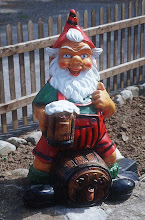
My first brew was an India Pale Ale, or IPA. It wass based on Charlie Papazian's Palialia India Pale Ale. This was an extract beer which means that the sugars for the beer were in the form of malt extract. The ingredients for 5 gallons were:
- 7 lbs light dry malt extract (light DME)
- 1 lb crystal 20L malt
- 0.5 lbs toasted malted barley
- 1.5 oz Northern Brewer hops (bittering hops)
- 0.75 Cascade hops (finishing hops)
- 1 pkg Safale S-04 yeast
- 2 tsp gypsum (water conditioner)
- 1 tsp Irish Moss
Papazian describes how to toast malted barley, but I found roasted barley at the homebrew shop. Roasted barley is darker than toasted barley, but I thought I'd give it a try and substitute it for the toasted barley. I had the homebrew shop crush the crystal malt and roasted barley for me and got to work.
First you make a tea.....
I took 2 gallons of water, added the gypsum and heated it in my brew kettle to 150 degrees. I put the crushed grain (crystal and roasted barley) into a muslin grain bag and steeped it in the 150 degree water for 30 minutes. This made a barley tea that added flavor, body and color to the beer. After 30 minutes, I drained the water out of my "teabag" being careful not to squeeze the bag. Squeezing at this point can release tannins into your tea, making the beer bitter.
Next a 60 minute boil ....
Into the tea I added the DME and brought the whole thing to a boil. The stuff in the brew kettle was now wort, basically beer without alcohol. As wort approaches a boil, it foams up. You have to be careful to stir the wort and lower the heat or you'll get a boilover which believe me is not fun to clean up. Having a large brew kettle will help with the boilover because of the space in the kettle for the wort to foam. This foaming is known as the "hot break" and is important to achieve to help precipitate proteins in the beer to prevent cloudiness.
After the hot break and when the wort came to a rolling boil, I added the Northern Brewer Hops. I used another muslin bag to contain the hops as it helped keep the amount of sediment in the wort to a minimum. I then boiled the wort for 50 minutes. I added the Irish moss which is a seaweed that helps further coagulate proteins in the wort that can lead to cloudy beer. With 2 minutes left, I added the Cascade hops to the hop bag and finished the boil.
Cool it quickly...
The brew pot went into an icebath in the sink to cool to below 80 degrees. At this point, everything that touched the wort must be sanitized to prevent an infection. Infected beer smells and tastes horrible, but if you did drink it, it wouldn't make you sick.
After the wort was cooled down I poured it into a sanitized fermentation bucket. I poured the wort through a strainer to filter out the coagulated proteins and bits of hops that might get through the bag. I made sure to splash the wort around during the pour to ensure that the wort got oxygenated to ensure good yeast action.
I measured the specific gravity to estimate the percent alcohol. It was 1.070.
I opened the yeast package, poured it into the bucket, put on the lid and an airlock and into a cool spot for the next week.
Waiting...
After a week, I transfered the beer (now its beer!) into another sanitized fermentation bucket. Lid, airlock, another week.
Its ready!!...
After fermenting for two weeks, the beer was ready. The final gravity was 1.021 which meant that the beer had an alcohol by volume (ABV) of 6.4 %. Not bad.
I siphoned the beer into a sanitized keg, chilled it, put it on CO2 to carbonate and in a couple of days it was ready to drink.
The Verdict...
Wow. This stuff is great! Smooth, good balance of malt sweetness and hop bitterness. It was really good immediately, but got much better as it aged in the keg.
Time taken:
Brewing - less than 3 hours
Fermenting - 2 weeks
Carbonation - 2 days



